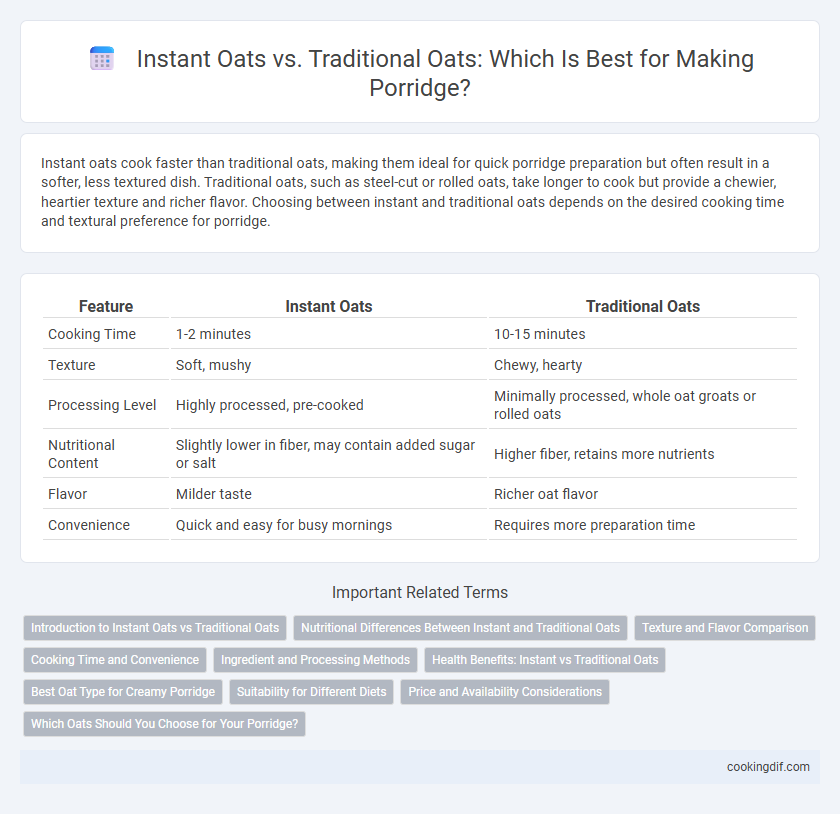Instant oats cook faster than traditional oats, making them ideal for quick porridge preparation but often result in a softer, less textured dish. Traditional oats, such as steel-cut or rolled oats, take longer to cook but provide a chewier, heartier texture and richer flavor. Choosing between instant and traditional oats depends on the desired cooking time and textural preference for porridge.
Table of Comparison
| Feature | Instant Oats | Traditional Oats |
|---|---|---|
| Cooking Time | 1-2 minutes | 10-15 minutes |
| Texture | Soft, mushy | Chewy, hearty |
| Processing Level | Highly processed, pre-cooked | Minimally processed, whole oat groats or rolled oats |
| Nutritional Content | Slightly lower in fiber, may contain added sugar or salt | Higher fiber, retains more nutrients |
| Flavor | Milder taste | Richer oat flavor |
| Convenience | Quick and easy for busy mornings | Requires more preparation time |
Introduction to Instant Oats vs Traditional Oats
Instant oats are pre-cooked, dried, and rolled thinner than traditional oats, allowing for quicker preparation and a softer texture in porridge. Traditional oats, often known as old-fashioned or rolled oats, retain more of their natural structure, resulting in a chewier texture and longer cooking time. Nutritionally, both types provide essential fiber and nutrients, but instant oats may have a slightly higher glycemic index due to the additional processing.
Nutritional Differences Between Instant and Traditional Oats
Instant oats contain slightly fewer nutrients than traditional oats due to processing methods that reduce fiber content and increase glycemic index, impacting blood sugar levels more significantly. Traditional oats retain higher levels of beta-glucan, which promotes heart health and improves cholesterol regulation. Both types provide essential vitamins, minerals, and antioxidants, but traditional oats deliver more sustained energy and greater satiety.
Texture and Flavor Comparison
Instant oats offer a smoother, creamier texture with a quicker cooking time, making them ideal for fast preparation but often lacking the chewy bite found in traditional oats. Traditional oats provide a heartier, more robust flavor and a chewier texture that enhances the porridge experience through longer cooking and absorption of milk or water. The choice between instant and traditional oats depends on preference for convenience versus depth of texture and flavor intensity.
Cooking Time and Convenience
Instant oats cook in about 1 to 3 minutes, offering unmatched convenience for quick porridge preparation, while traditional oats typically require 10 to 15 minutes of cooking for the best texture and flavor. The fine processing of instant oats allows rapid water absorption, making them ideal for busy mornings but often resulting in a softer, less chewy porridge. Traditional oats, such as rolled or steel-cut varieties, demand longer cooking times but produce a heartier, more satisfying consistency prized by porridge enthusiasts.
Ingredient and Processing Methods
Instant oats undergo extensive processing through pre-cooking, drying, and rolling into thinner flakes, which reduces cooking time but can lead to a softer texture and slightly diminished nutrient density compared to traditional oats. Traditional oats, including steel-cut and rolled oats, are minimally processed, maintaining intact whole grain components that offer higher fiber content and a chewier texture ideal for porridge. The difference in ingredient integrity and processing methods impacts the glycemic index, with traditional oats providing a slower release of energy due to less processing than instant oats.
Health Benefits: Instant vs Traditional Oats
Traditional oats retain more fiber and nutrients due to minimal processing, promoting better heart health and sustained energy release. Instant oats, while convenient and quick to prepare, often contain added sugars and lower fiber content, which can affect blood sugar levels more rapidly. Choosing traditional oats for porridge supports improved digestion and longer-lasting satiety compared to instant oats.
Best Oat Type for Creamy Porridge
Instant oats absorb water quickly and cook within minutes, making them ideal for quick, creamy porridge with a soft texture. Traditional oats, such as rolled or steel-cut, require longer cooking times but provide a thicker, chewier porridge with a richer, nuttier flavor. For the creamiest porridge, rolled oats strike the best balance between smooth texture and substantial mouthfeel.
Suitability for Different Diets
Instant oats offer a quick and convenient option for porridge, featuring a finer texture that suits individuals seeking rapid digestion or a softer consistency, making them ideal for sensitive stomachs or low-fiber diets. Traditional oats retain their whole-grain structure, providing higher fiber content and a slower glycemic response, which supports heart health and weight management, suitable for high-fiber, low-GI, and diabetic-friendly diets. Both types fit gluten-free and vegan diets when sourced without cross-contamination, but traditional oats offer superior nutritional benefits for balanced, fiber-rich meal plans.
Price and Availability Considerations
Instant oats typically cost more per serving than traditional oats due to added processing and convenience packaging, making traditional oats a more budget-friendly option for porridge. Traditional oats are widely available in bulk at supermarkets and health food stores, often with better pricing and less packaging waste. Instant oats offer greater availability in single-serve packets and are popular in convenience settings, but their higher price and limited bulk options can affect long-term affordability.
Which Oats Should You Choose for Your Porridge?
Instant oats cook faster and have a finer texture, ideal for quick porridge preparation, while traditional oats, such as steel-cut or rolled oats, offer a chewier texture and richer flavor but require longer cooking time. Nutritionally, traditional oats retain more fiber and have a lower glycemic index compared to instant oats, making them a better choice for sustained energy release. Choosing between instant and traditional oats depends on balancing convenience with texture and nutritional benefits for your porridge.
Instant oats vs Traditional oats for porridge Infographic

 cookingdif.com
cookingdif.com